Apec Water Essence Reverse Osmosis System Owners Manual
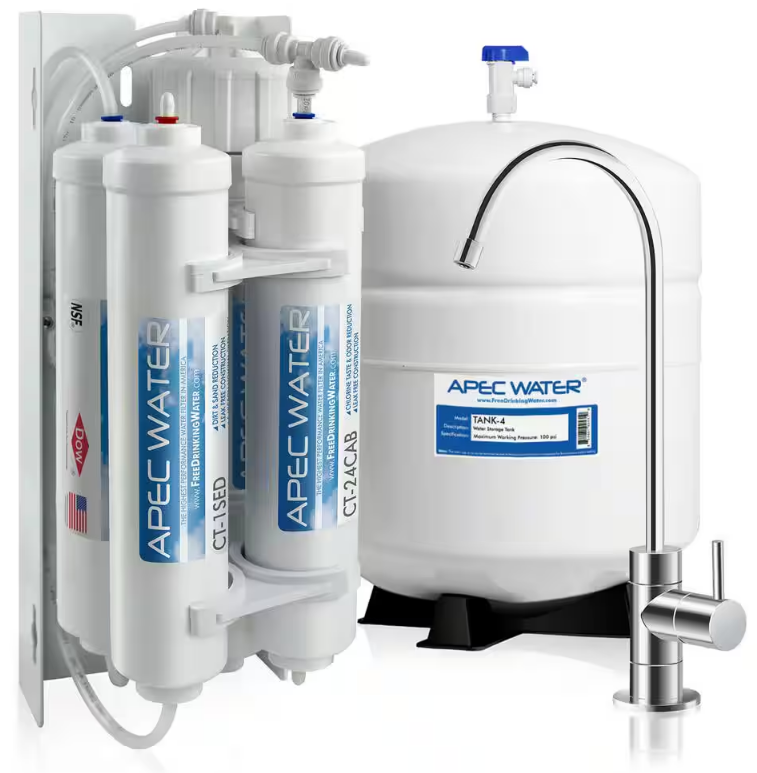
Content
APEC Water Essence Reverse Osmosis System Introduction
The APEC Water Essence Reverse Osmosis System is a state-of-the-art water filtration system designed to provide homeowners with clean and safe drinking water. Launched in 2019, this system has quickly gained popularity for its high-efficiency performance and user-friendly design. The estimated price of the system is around $250, making it an affordable solution for households looking to upgrade their water quality.
Detailed Specifications
The APEC Water Essence Reverse Osmosis System features a 5-stage filtration process that includes:
- Stage 1: High-capacity sediment filter to remove dust, rust, and other particles.
- Stage 2 & 3: Dual high-capacity activated carbon block filters to eliminate chlorine, taste, and odor.
- Stage 4: High-rejection TFC RO membrane to remove contaminants down to 0.0001 micron.
- Stage 5: Post-carbon filter to polish and improve taste.
Additional features include a lead-free faucet, quick-connect fittings, and a compact design that fits under most kitchen sinks.
This system is specifically engineered to remove up to 99% of contaminants from water, including heavy metals, bacteria, viruses, and other impurities. Its purpose is to ensure that the water you drink is not only safe but also tastes better. The APEC Water Essence Reverse Osmosis System is ideal for families, individuals, and businesses seeking a reliable and efficient water purification solution.
Please read and become familiar with instructions and parts needed before proceeding with the installation.
(This manual is constructed for standard APEC Essence RO System. For ROES-PH75 and ROES-UV75 system installation, please refer to the included addendum.)
BEFORE INSTALLATION
Inspect the system:
Please take the system and all the components out of the box. Inspect the system and all the connection fittings carefully, make sure nothing is damaged during shipping. If any part is cracked or broken, please do not proceed with the installation and contact APEC or your distributor for an exchange or diagnosis.
Recommended tools list:
- Variable speed drill
- Drill bit:1/4” (for the waste line), 1/8” (as pilot, not mandatory), and 1/2” (for standard faucet hole, air-gap faucet requires 1&1/4” hole)
- 5/8”, 9/16” open-end wrench, or adjustable wrench, pliers
- Phillips screwdriver
- Utility knife, or scissors
- Teflon tape
Operating Parameter
- Operating pressure: 85psi maximum
- Feed water temperature: 40 – 100 degree F (4-37 degree C)
- Do not connect this unit to hot water source
- Install the RO in a sheltered environment, avoid exposure to hot and cold weather or under direct sunlight.
General Installation/Operation/Maintenance Requirements
- Installation needs to comply with state and local laws and regulations.
- System must be installed indoor away from possible environmental damage.
- Do not use with water that is microbiologically unsafe or of unknown quality without adequate disinfection before or after system. Systems certified for cyst reduction may be used on disinfected water that may contain filterable cysts.
- This reverse osmosis system contains a replaceable treatment component critical for effective reduction of total dissolved solids. The product water shall be tested periodically to verify that the system is performing satisfactorily.
Description
The APEC Water Essence Reverse Osmosis System is a comprehensive water filtration unit that is both durable and efficient. The system’s 5-stage process ensures thorough removal of contaminants, resulting in clean and fresh-tasting water. The system’s design is sleek and compact, making it easy to install and maintain. The lead-free faucet adds a touch of elegance to any kitchen while providing a convenient way to dispense filtered water.
The system also includes easy-to-replace filters, reducing maintenance costs and ensuring consistent performance over time. With its high-capacity filters and robust construction, the APEC Water Essence Reverse Osmosis System is a reliable choice for long-term water purification needs.
Components included with the ROES system
Make sure you have all these parts before starting installation.

Component Itemization

- Bracket
- Membrane and housing (4th-stage filter)
- In-line carbon filter (5th-stage filter)
- Sediment pre-filter and housing (1st-stage filter)
- Carbon block pre-filter and housing (2nd-stage filter)
- Carbon block pre-filter and housing (3rd-stage filter)
- Storage tank
- Tank ball valve
- ASO – Automatic Shut Off valve
- Check valve (Internal check valve encased in plastic fitting)
- T-fitting
- Feed water inlet
- Product (filtered) water outlet
THERE ARE TWO PARTS TO INSTALLING THE RO SYSTEM:
- Part I. Assemble the filters and housings onto the main system
- Part II. Installing the system
Note: The RO Membrane Element has already been pre-installed.
ASSEMBLE THE FILTERS AND HOUSINGS ONTO THE MAIN SYSTEM
Remove plastic/paper wrappings on the 3 filters and housings, put filters into the 3 housings, and assemble the housings onto the main system as follows:
- Fig. 1: Stand the 3 housings upright. Make sure each housing has a rubber O-ring in its groove. Put the Essence sediment filter (FI-ES-SED10) into the “1st stage” housing on the right. Put the Essence carbon filters (FI-ES-CAB10) into the “2nd and 3rd stage” housing in the middle and left.
- Fig. 2: Starting from the 3rd stage housing on the left, hand twist the housing onto the main system turning counterclockwise, one by one, for all 3 housings.
- Fig. 3: Use the wrench provided to completely tighten the housing starting from the 1st-stage. Repeat this step for the 2nd stage housing in the middle, and for the 3rd stage housing on the left.

Note: For some people, it is easier to use the wrench with the system laid down (face up).
Setup Guide
Setting up the APEC Water Essence Reverse Osmosis System is relatively straightforward. Here are the key steps:
- Shut off the main water supply and remove the old faucet if applicable.
- Install the RO system under the sink by connecting it to the cold water line.
- Attach the lead-free faucet to the sink’s countertop.
- Connect all tubing according to the provided diagram.
- Turn on the water supply and check for leaks.
- Allow the system to flush out any air or impurities before use.
Refer to the detailed installation manual provided with the system for specific instructions and illustrations.
INSTALLING THE SYSTEM
- Space: Make sure there is sufficient space under the counter for installation (an area of about 17”L x 6”W x 18”H for the system, 11”D x 18”H for tank). The RO system is best installed under the kitchen sink. But if that is not feasible, you can install the system anywhere where there is a cold water supply with sufficient water pressure for the chosen RO model and an outlet to drain off the waste water from the system.
- Mounting: No need to mount the RO system on the wall. The RO system can stand in the sink cabinet without mounting, making future filter changes easy and convenient. If you prefer to mount the system to the wall, please make sure it can be taken down easily for filter replacement.
- Feed Water: RO systems are designed to treat both hard and soft water and can handle incoming TDS levels up to 2,000 ppm.
Step 1: Feed Water Connection
- Locate the Cold water supply valve under the kitchen sink (the round or oblong handle on the right side). Turn off the incoming cold water completely by turning the shut off handle clockwise.
Note: If the cold water shut off valve can not turn off the water, the main water supply to the house must be shut off for the installation. Another option is to use a “self piercing saddle valve” from APEC or from a local hardware store. Feed Water Adaptor (1/2” to 3/8”): See Fig. 4. The Feed Water Adaptor comes with a separate Needle Valve. The Adaptor goes inline onto your 1/2” or 3/8” cold water pipe. The Needle Valve portion screws onto the Adaptor as shown in Fig. 4A.
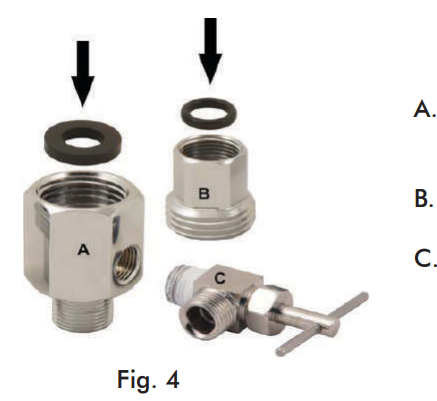
- 1/2” x 3/8” Male-Female Water Supply Adapter with O-ring.
- 1/2” x 3/8” Male-Female Converter with O-ring.
- 1/4” x 1/8” Male Needle Valve.
- Fig. 4A: Needle Valve Installation. Attach the needle valve (C) to the water supply adapter (A). Please apply 5-6 wraps of Teflon tape to needle valve prior to connecting it to the water supply adapter (A).
- Fig. 4B: If your pipe has a 1/2” Connection, by attaching the 1/2” x 3/8” converter (B) to the Male end of the water supply adapter (A), you now have a 1/2” Male and Female water supply adapter.
Fig. 4C: If your pipe has a 3/8” Connection, by attaching the 1/2” x 3/8” converter (B) to the Female end of the water supply adapter (A), you now have a 3/8” Male and Female water supply adapter.
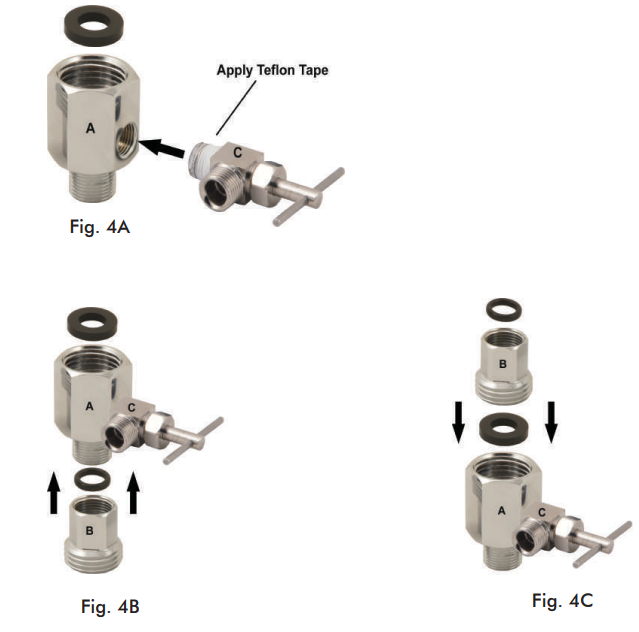
Recommend Connection For Flex Line Riser: See Fig. 5A. & Fig. 5D Loosen nut and separate cold water riser tube from shut off valve. Gently bend riser tube so that the Feed Water Adapter (Fig 4) fits onto the shut off valve. If your riser tube has no built-in washer, then fit the cone-shaped washer provided onto the riser tube. Connect the riser tube, feed water adapter, and shut off valve together and tighten.

- For Solid Copper Riser: See Fig. 5B. Follow the same procedure as for flex line. If the copper riser cannot bend, this it’s best to replace it with a flex line riser. Fit the feed water adaptor to the shut off valve the same way as described above.
Option Connection Point: See Fig. 5E. The feed water adapter can also be installed between the riser tube and faucet shank. Loosen nut and separate cold water riser tube from faucet shank. Gently bend riser tube so that the Feed Water Adapter fits onto the faucet shank. If your riser tube has no built-in washer, then fit the cone-shaped washer provided onto the riser tube. Connect the riser tube, feed water adapter, and faucet shank together and tighten.
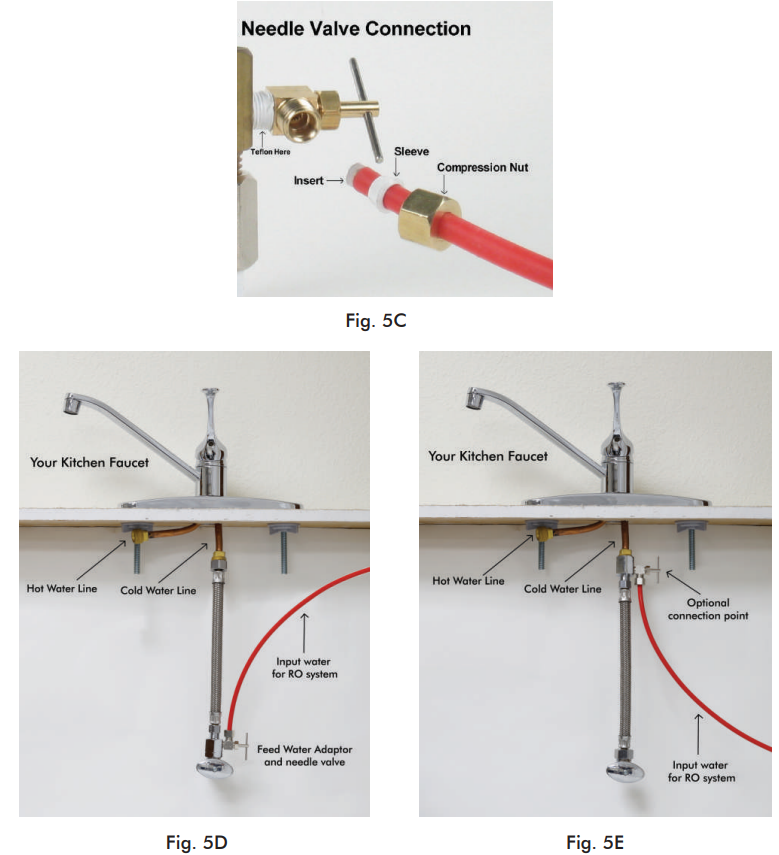
- Needle Valve: See Fig. 5C. Screw the Needle Valve onto the Adaptor tightly. Apply 6-8 rounds of Teflon tape onto Needle Valve before attaching it to the Adaptor.
- To open needle valve: Turn needle handle counter-clockwise.
- To close needle valve: Turn needle handle clockwise.
Test for leaks at this point: Close the Needle Valve (turn needle handle clockwise all the way in to close). Turn ON the cold water supply to the sink faucet. If the Needle Valve or the Adaptor leaks, check the connection and try applying more Teflon tape or tighten the brass nut some more to stop the leak.
Step 2: Drain Saddle Installation
Note: To avoid possible drainage noise, mount the drain line as low as possible on the vertical tailpiece, or on the horizontal tailpiece.
There is constant water pressure “packed” inside the RO system which blocks the waste water from backing up into the system. So the waste water is “forced-drained,” not “gravity-drained.”
Fig. 6: The drain saddle assembly should be installed above the trap and on the vertical or horizontal tailpiece. To reduce the drainage noise, mount the drain line as low as possible above the trap, or on the horizontal tailpiece.
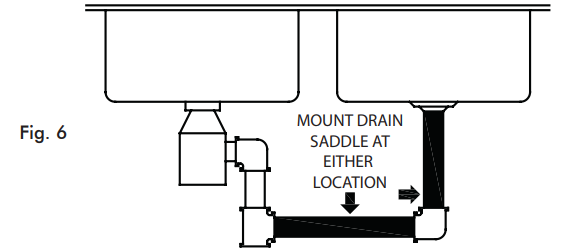
Fig. 7: Mark the position of the hole on the drain pipe and drill a 1/4’’ hole through one side of the drain pipe. There is a piece of self-adhesive sponge provided. Glue this sponge to the inside of the saddle, this will cushion any gap between the saddle and the pipe. Make sure the hole on the sponge is thoroughly punched out and is aligned to the hole on the saddle.
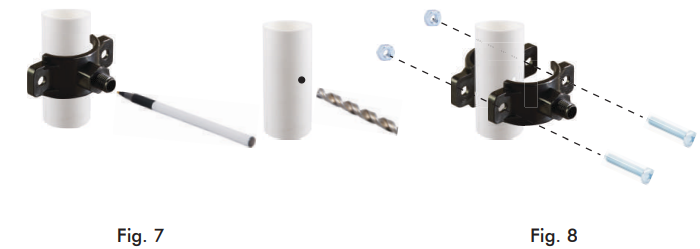
- Fig. 8, 8A: Make sure to align the drain saddle hole to the drilled hole perfectly. Misaligning these two holes will block the waste water and cause membrane damage. Attach the drain saddle to the drain pipe and tighten the two screws evenly.
Once the drain saddle is secured, slide the drain saddle compression nut over the 1/4” black drain line and connect the drain line to the saddle. DO NOT use an “Insert” on the drain tube.

Step 3: Drill A Hole For The RO Faucet
- Drill a 1/2” diameter hole for a standard RO faucet. (Air-Gap faucet: drill a 1&1/4” hole.)
- For best results, use a 1/2” carbide-tipped masonry drill bit. Wear safety glasses to protect your eyes while drilling the faucet hole.
Note: No need to drill a hole if an existing hole is available:
- Spare hole: If there is a spare hole in the sink covered by a chrome cover, simply remove the chrome cover and install the RO faucet there.
- Spray hose: If the spray hose is not in use, remove the hose and mount the RO faucet there. Remember to plug up the outlet under the main faucet. If the spray hose uses a diverter at the base of the spout, be sure to remove it to avoid trouble later on.
- Hanging faucet: If drilling a hole is not feasible (i.e., rental home, drill tool not available, etc.), the faucet can hang on the cabinet door or wherever it is convenient. Be creative!
When drilling a hole for the RO faucet, choose a location that looks good, works well, and is most convenient for dispensing pure water. An ample flat area is required for the faucet base so that the faucet can be drawn down tightly.
- Faucet location: Make sure the faucet stud will be accessible from below when the hole is drilled. If space is not available on the upper sink area, the faucet can be located on the countertop by the edge of the sink. If the countertop is ceramic tile, the method for drilling the hole will be the same as for porcelain sinks.
- For Stainless Steel Sink: Before using a 1/2” carbide drill bit, an indent should be made with a center punch to keep the drill bit from walking. A small pilot hole will also aid the drill bit.
- For Porcelain Sink: Porcelain-enameled sinks can readily be chipped if care is not exercised when drilling the hole. Before starting the drill motor, apply firm downward pressure on the bit until a crunching occurs. This will help keep the drill bit from walking when starting the hole. A small pilot hole will also aid the drill bit.
Note: Immediately after the hole drilling is done, clean up all metal chips, as metal chips will stain the porcelain!
Step 4: Mounting The Faucet
Mount the faucet as shown in Fig. 9.
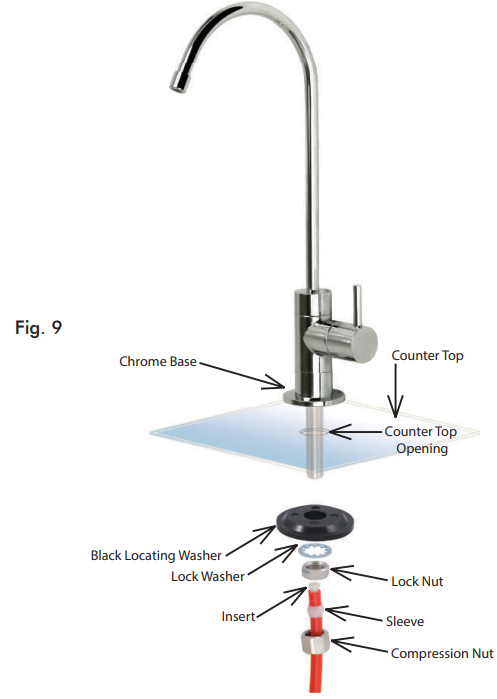
- Connect the Clear line to the faucet.
- The faucet has a solid metal handle that controls the flow of purified water exiting the faucet. Turn the handle to the horizontal position to release the water and vertically to shut off.
Step 5: Positioning The System
- Main System: The main system can stand in the sink cabinet. There is no need to mount the system to the wall. If you prefer to mount the system to the wall, please make sure it can be taken down easily for filter replacement.
- Tank: The storage tank can lay on its side if needed. The tank works fine in this position. If the tank cannot fit under the kitchen sink, it can be placed elsewhere up to 20 feet away from the RO system without much pressure loss.
Step 6: Connecting The System
Fitting Types:
There are 2 types of fittings provided for connecting the system.
- Metal compression nut fitting (comes with 1 insert, 1 sleeve, 1 nut)
Fig. 10: Important! Use a plastic sleeve on the plastic tubing we provide. Do not use a metal sleeve on plastic tubing or the connection will leak!
How to connect:
- Slide the compression nut onto the tubing.
- Slide the plastic sleeve onto the tubing.
- Insert the “insert” into the tubing.
- Insert the tubing into the opening of the fitting.
- Slide the brass nut up, then tighten the nut with a wrench. No Teflon tape!
Note: An extra metal sleeve is provided in case you need to connect your own metal tubing. Use Teflon tape if connecting metal tubing.
- Quick-Connect (QC) fitting (no insert, sleeve, or nut)
How to connect:
Fig.10A: Push the tubing into the Quick Connect fitting, then gently pull back on the tubing to make sure the connection is secure. No inserts, sleeve, or nuts are needed to secure the connection. No Teflon tape!
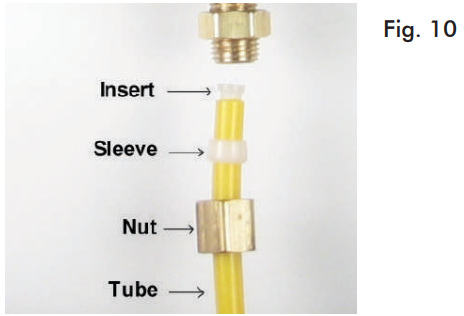
To disconnect:
Fig.10B: Push in and hold down on the collet ring square against the fitting. With the collet held in this position, the tube can be removed.

Note: The QC fittings come with an End Plug that needs to be removed before the tubing can be connected.
Summary of Tubing Connections
There are 4 connections: See Fig. 11 & Fig. 11A.
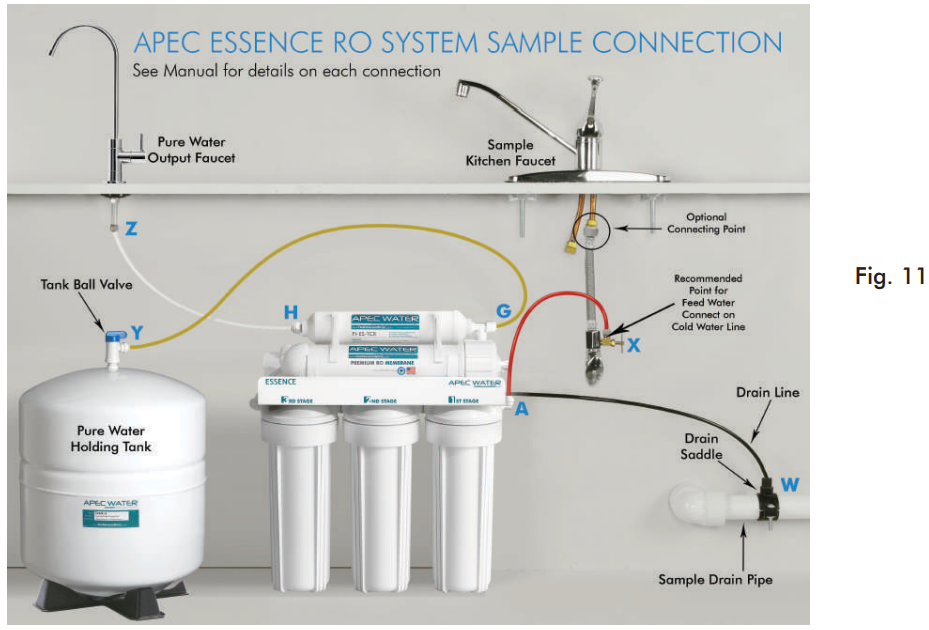
- Point A to X: Connect RO to COLD water supply — Red tubing.
- Point G to Y: Connect product water from 5th-stage filter to tank — Yellow tubing. This tubing is a two-way line. Product water enters and leaves the tank via this line.
- Point H to Z: Connect product water from 5th-stage output to RO faucet — Clear tubing.
- Drain line to W: Connect waste water from 4th-stage membrane to drain outlet — Black tubing.
Details on Tubing Connections
To ensure a smooth and correct installation, please connect the water lines following the sequence and order outlined below. Refer to Fig. 11 & 11A for proper point locations.

- Point Z - Faucet connection:
- Tubing color: Clear tubing.
- Fitting type: Metal compression nut fitting. Use a plastic sleeve. Add “insert” to tubing. No Teflon tape here. Tighten the nut with a wrench.
- Note: DO NOT use a metal sleeve on plastic tubing, it will cause leakage! A metal sleeve is provided for metal tubing usage. Apply Teflon tape if using metal tubing and sleeve.
- Point X - Feed water connection:
- Tubing color: Red tubing.
- Fitting type: Metal compression nut fitting. Use a plastic sleeve. Add “insert” to tubing. No Teflon tape here. Tighten the nut with a wrench.
- Tip: If Point Z or Point X leaks after you have tightened the brass nut, check to make sure you did put the plastic “insert” into the tubing. If the insert is already in place, then try applying Teflon tape from the threaded metal stud all the way to the plastic tubing, wrapping the whole connection with 8-10 rounds of Teflon tape. Smooth out the tape on the threaded part with your fingers. Tighten the brass nut again. This should stop the leak.
- Point W - Wastewater connection:
- Tubing color: Black tubing.
- Fitting type: Plastic compression nut fitting with built-in sleeve. No Teflon tape needed. Do not add “insert” into Black tubing. Simply secure the drain line by tightening the compression nut.
- Point A - System water inlet (to Stage 1 prefilter) connection:
- Tubing color: Red tubing.
- Fitting type: Quick Connect fitting. Simply push the Red tubing into the QC fitting. No Inserts, Sleeves, or Nuts are needed to secure the connection. No Teflon tape needed here.
- Point H - Stage-5 filtered water to faucet connection:
- Tubing color: Clear tubing.
- Fitting type: Quick Connect fitting. Simply push the Clear tubing into the QC fitting. No Inserts, Sleeves, or Nuts are needed to secure the connection. No Teflon tape needed here.
- Point G - Stage-5 filter’s T-fitting connection:
- Tubing color: Yellow tubing.
- Fitting type: Quick Connect fitting. Simply push the Yellow tubing into the QC fitting. No Inserts, Sleeves, or Nuts are needed to secure the connection. No Teflon tape needed here.
- Point Y - Tank’s input & output connection:
- Prepare tank: Apply 6-8 wraps of Teflon tape to the tank’s threaded Output stem on top of the tank (remove rubber cap if there is one). Screw the tank valve onto the Output stem.
- Tubing color: Yellow tubing.
Fitting type: Quick-Connect fitting on ball valve. Simply push the Yellow tubing into the valve port.
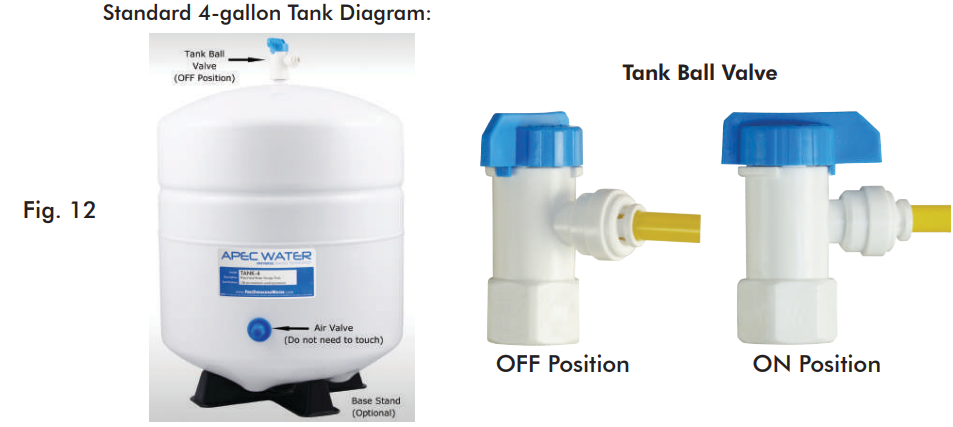
Option: Ice-maker Connection
If you want to connect product water from the RO to your ice-maker, you will need:
- One T-fitting, preferably the quick-connect type fitting
- Extra 1/4" tubing long enough to go from the RO system to your ice-maker
- Optional: One shut-off valve, preferably the quick-connect type.
See Fig.13: Before connecting the product water line from Point Z to H, add a T-fitting near point H to divert product water to both the ice-maker and the faucet.
Using RO for Ice-maker only:
If you want the RO to feed your ice-maker (fridge) only, you should still connect the RO faucet as a second outlet. This allows you to drain the tank, flush new filters through the faucet rather than through your ice-maker line. You can hang the faucet by the system and not mount it.
Option: Multiple Outputs - Add Shut-Off Valve:
If your RO is feeding several output points (icemaker, fridge, bathroom), you should add a Shut-Off valve to each output line (except the RO spigot line). This way, if you ever need to diagnose a problem in the system, you can easily shut off these lines to isolate the water flow for accurate troubleshooting.

Step 7: System Start-Up
- Turn on feed water: Slowly, turn on your Cold water supply. Open the Needle Valve (turn counterclockwise) to allow the raw water to enter the system. Check for leaks!
- Open tank valve: Open the tank’s ball valve to allow water to enter the tank. The tank’s valve is “On” when the valve handle is parallel (in the same direction) with the valve’s outlet (see Fig. 12). Check for leaks!
- Wait for tank to fill: Before usage, allow the tank to fill. The tank normally takes 2-3 hours to fill. When the tank is filled, the RO will shut off automatically.
- Drain tank: Do not use the first tank of water! Drain it out to flush the system and new filters. Lift the faucet lever up into a locked position to drain the tank. Let the tank refill again and the pure water is ready for use.
- Clean up area: Allow the system to run while cleaning up tools and the work area.
- Check for leaks! Make sure there are no leaks at joints, fittings, valves, and tubing connections.
Troubleshooting
Common issues with the APEC Water Essence Reverse Osmosis System include:
- No Water Flow: Check for kinks in tubing, ensure all connections are secure, and verify that the water supply is turned on.
- Inspect all connections and tighten any loose fittings.
- Replace filters as recommended or check for damage to any stage of the filtration process.
Always refer to the troubleshooting section in the manual for detailed solutions and follow safety precautions to avoid any potential hazards.
Pros & Cons
Pros
- Removes up to 99% of contaminants.
- Easy installation and maintenance.
- Fits under most kitchen sinks.
- Competitively priced compared to other RO systems.
Cons
- Produces wastewater during the filtration process.
- Requires periodic filter replacements which can be costly over time.
- May have a slower flow rate compared to non-RO systems.
Customer Reviews
Customers have praised the APEC Water Essence Reverse Osmosis System for its effectiveness in removing contaminants and improving water taste. Many reviewers have noted the ease of installation and maintenance. However, some users have mentioned concerns about the system’s wastewater generation and slower water flow rate.
Common complaints include issues with customer service support and occasional leaks if not properly installed.
Faqs
What is the typical lifespan of filters in the APEC Water Essence Reverse Osmosis System?
Can I install the APEC Water Essence Reverse Osmosis System myself?
How often should I clean and maintain the system?
Why does my RO system produce wastewater?
Is it safe to drink water from this system during pregnancy?
Can this system remove fluoride from tap water?
What kind of certifications does this product have?
Can I use this system with well water?
How much space does this system require under my kitchen sink?
Leave a Comment
